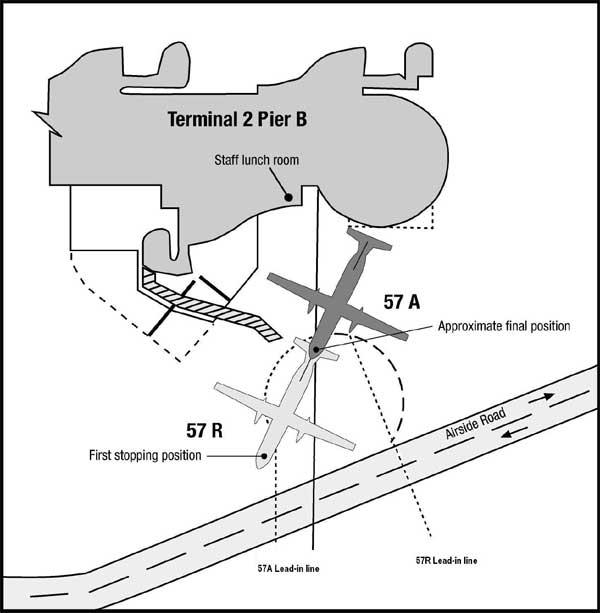On 19 February 2005 at 1310 Eastern Daylight-saving Time, a de Havilland Canada DHC-8-102 aircraft, registered VH-TQR, was being operated on a scheduled regular public transport service from Canberra, ACT, to Sydney, NSW. On arrival at the terminal the crew was given marshalling instructions from ground staff to taxi onto bay 57R and stop. The pilot in command (PIC) then reversed the aircraft until instructed to stop by an off-duty marshaller who had seen that the tail of the aircraft was very near to the Terminal 2 building.
While en route to Sydney, the crew had contacted the operator's movement control officer to request a parking bay and to advise that the weather radar was unserviceable. The crew were advised to expect a 'reverse bay'. The crew discussed the requirement to park on a reverse bay. They were uncertain if the aircraft was to be reversed onto the correct stopping point. There was no discussion about the marshalling signals they would expect to see. The PIC referred to the aircraft's parking bay diagrams (see Appendix A) and was satisfied that the lead in lines painted on the tarmac and the signals of the marshaller would provide sufficient guidance.
After vacating runway 34 left, the crew was advised by the operator to park on bay 57 reverse (57R) so that engineers could repair the weather radar. Bay 57R is located near the southern end of Terminal 2 Pier B (see Figure 1) and required aircraft to park with the nose pointing away from the terminal.
Figure 1: Parking bay 57 (for illustrative purposes only)
The bay is also marked 57A for aircraft parked facing the terminal. Bay 57R was used to park aircraft in conditions of strong westerly winds, or if engineering staff required the nose of the aircraft to be facing away from the terminal building. The bay was commonly referred to by both ground staff and flight crew as 57 reverse or a reverse parking bay.
The PIC taxied the aircraft to Bay 57R, where it was marshalled into position and stopped by the crew when they observed the marshaller cross his arms once at approximately chest height. The position of the aircraft at that stage was correct for Bay 57R. However, the crew were concerned that the aircraft was positioned too close to a vehicle access road marked on the movement area and after briefly discussing between themselves the meaning of the signal used by the marshaller, decided that the instruction was to reverse. The PIC then reversed the aircraft and anticipated that the marshaller would signal them to stop at the correct point. The crew noted that the marshaller was walking toward the aircraft as it reversed, using hand signals which they interpreted as confirmation of the reverse manoeuvre, but which the marshaller intended as a signal to stop.
The marshaller had been told that the aircraft had a problem with the weather radar, which required that the ground power unit (GPU) be positioned away from the aircraft's nose. When the aircraft started to reverse the marshaller thought the crew were also positioning the aircraft away from the GPU.
Three off-duty marshallers were in a lunchroom, adjacent to bay 57R, when the shift supervisor observed the aircraft being marshalled onto the bay. He then saw the aircraft reversing and alerted the other two marshallers in the room to the situation. They observed the aircraft marshaller signal the PIC to stop the aircraft, by crossing his arms repeatedly at chest height. One of the off-duty marshallers ran out onto the tarmac to the aircraft's two o'clock position1 and signalled the crew to stop by crossing his arms over his head. The tail of the aircraft was estimated by that off-duty marshaller to be within 1 m of the terminal. The shift supervisor also went onto the tarmac and marshalled the aircraft forward to the correct bay 57R stop position.
The on-duty aircraft marshaller had received training on aircraft ground marshalling in accordance with the operator's ramp handling course document. The description for 'stop' in that document was in accordance with the Civil Aviation Safety Authority Civil Aviation Order (CAO) 20.3 Issue 5, Air Service Operations, Marshalling and Parking of Aircraft.
Stop is indicated by the arms to be repeatedly crossed above the head. (the rapidity of the arm movement related to the urgency of the stop, ie. the faster the movement the quicker the stop).
Other documentation used by the operator that included marshalling signals were a Customer Service Ground Handling Manual and a Flight Deck Engineering Manual that both stated:
Arms extended to full length above head in vertical position with bats or wands held steady. Widely accepted signal for use when there is no urgent stop requirement.
Although not in accordance with CAO 20.3, this signal was recognised by ground staff and by flight crew to indicate stop.
All of the manuals reviewed as part of the investigation stated that marshalling bats should be used to minimise the risk of misinterpretation. However, marshalling conducted by the operator during daylight was conducted without the use of marshalling bats.
1. The numbers on a clock are used to describe relative position, where 12 o'clock is directly in front. For example, a person or object observed abeam to the left of an aircraft would be said to be at 9 o'clock.



